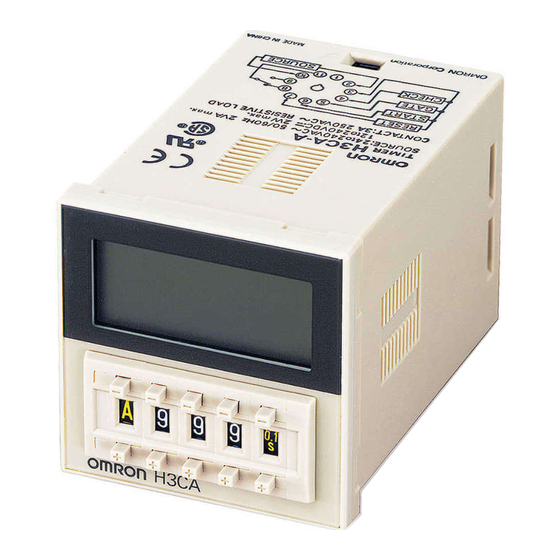Advertisement
Product Operation and Setup Instructions
Please read and save these instructions. Read carefully before attempting to assemble, install, operate, or maintain the
product described. Protect yourself and others by observing all safety information. Failure to comply with instructions
could result in personal injury and/or property damage! Retain instructions for future reference.
OMRON
Description
OMRON multi-mode/multi-range solid-state timer is digital set
with wide 0.1 sec to 9990 hour range in a compact, 1/16 DIN
plug-in unit. Easy-to-read LCD time remaining bar graph and
output status indicators. Many control modes to match most
applications. Thumbwheel switch selects time unit, control
mode, and time limit setting. Wide supply range. Timer is UL
Recognized and CSA Certified.
Specifications
TIME DELAY
Adjustment ........ 5-digit switches
Range .............. 0.1 sec to 9,990
hours
Repeatability ... +/- 0.3%, +/- 0.05
seconds over specified
timing range
Reset Time .......... 0.5 sec max.
POWER
Operating Voltage -
24 to 240 VAC or 24 to 240 VDC
Power Consumption ....... AC 3VA
or DC 3W
Frequency .................... 50/60 Hz
OUTPUT
Type .................... Relay S.P.D.T.
Life .......... Mechanical -
10,000,000 operations
Dielectric ....... 2,000 volts RMS at
50/60 Hz between current carrying
and non-current carrying parts
This datasheet has been downloaded from
H3CA Solid-State Timer
H3CA Solid-State Timer
ENVIRONMENTAL
Operating Temperature ..... -14 to
Humidity ............... 35 to 85% RH
MECHANICAL
Termination ............... 11 pin plug
Mounting .....Panel, track, surface
GENERAL SAFETY
RECOMMENDATIONS
WARNING
!
Disconnect power when
connecting or disconnecting the
timer or its loads.
CAUTION
!
Do not change the time unit or
time range while the timer is in
operation. Otherwise, the timer
may malfunction or be damaged.
Be sure to turn off the power
supply to the timer before
changing any of the selections.
1. This timer should be wired by
qualified personnel according to
the National Electrical Code
(NEC) and local codes.
2. Do not connect input or contact
terminals to voltages higher
than those indicated on timer.
3. Protect the coil and load circuits
with properly rated fuses.
4. Do not install in damp or moist
locations.
5. Any application of this timer
should be designed to prevent
131 degrees F
bodily injury, or property
damage, in the event of product
failure or normal wearout of this
product.
GLOSSARY
No Voltage or Dry Contact
The inputs (Start, Reset, Gate,
and Check) on this timer are
considered a no voltage or dry
contact thus requires no external
voltage source to activate. Simply
connecting them to the common
terminal (Pin 3 or 15) via a switch,
relay contact, open collector
sensor, and etc., is all that is
required to activate each input.
Gate Input (Pause)
When the gate input is closed,
timing is temporarily stopped.
When the gate opens, timing
resumes at the point of
interruption.
Check Input
When check input is used i n ON-
delay mode, the elapse time
measurement of the set time is not
performed - especially useful
where ON-delay override is
desired. In Repeat Cycle mode,
the check input allows the timer to
be used like a binary flip-flop or
alternating relay.
http://www.digchip.com
at this
1A983
page
Advertisement
Table of Contents

Summary of Contents for Omron H3CA
- Page 1 H3CA Solid-State Timer H3CA Solid-State Timer OMRON Description OMRON multi-mode/multi-range solid-state timer is digital set 2. Do not connect input or contact terminals to voltages higher with wide 0.1 sec to 9990 hour range in a compact, 1/16 DIN than those indicated on timer.
- Page 2 Pin 16 is the NC contact. can be either a Pin 18 is the NO contact. AC or DC source Outputs: Pins 1,3,4,5,6, and 8 are the terminals for the H3CA-8 internal output relays. H3CA-8 Timed Timed Pin 1 is the COM for relay #1.
-
Page 3: Operation
The operation mode is fixed to "A" 9 - 11 load. Once the timer has timed in type H3CA-8 and H3CA-8H Figure 2 out from the trailing edge, it resets timers. and is ready for subsequent start... - Page 4 1A983 Product Operation and Setup Instructions Operation Mode E - Interval (Continued) Power-ON Start/Power-OFF reset: Connect start terminals (3 Power & 6). Upon application of power to 2 -10 the timer, timing starts. The output Less than set time relay is switched during timing, Start 3 - 6 either connecting or disconnecting load.
- Page 5 1A983 Product Operation and Setup Instructions Operation Mode H (Continued) Signal OFF-delay: Power is continuously applied. Power Timing begins at the trailing edge 2 -10 of the start input. The output relay is switched only during timing. Start 3 - 6 On for set time Power 2 -10...
- Page 6 1A983 Product Operation and Setup Instructions Application 2. Jumper one side of power 5. Time period begin each time (either pin 2 or 10) to COM of start input is closed and output relay (pin 11). opened. Load is activated only ON-DELAY Power-ON Start/ 3.
- Page 7 1A983 Product Operation and Setup Instructions 6. Reset timer by applying a switch SIGNAL OFF-DELAY ( ll ) Application (Continued) closure to reset input (pins 3 Refer to Figures A, B, and C and 7) or by removing power INTERVAL Power-ON Start/ from pins 2 or 10.
-
Page 8: Wiring Diagrams
Product Operation and Setup Instructions 1A983 Wiring Diagrams Jumper Reset wire Start H3CA-FA H3CA-A Reset Start Jumper wire Supply Voltage Supply voltage can be either a AC or DC Figure A Figure B Figures A, B, and C illustrate source... -
Page 9: Product Warranty
This warranty is voided if the product is altered in any way or suffers consequential damage due to negligence or misuse. Omron is not to suffer risk due to suitability or unsuitability or the results of the use of its products used in combination with any electrical or electronic components, circuits, systems assemblies, or any other materials or substances or environments.
















Need help?
Do you have a question about the H3CA and is the answer not in the manual?
Questions and answers